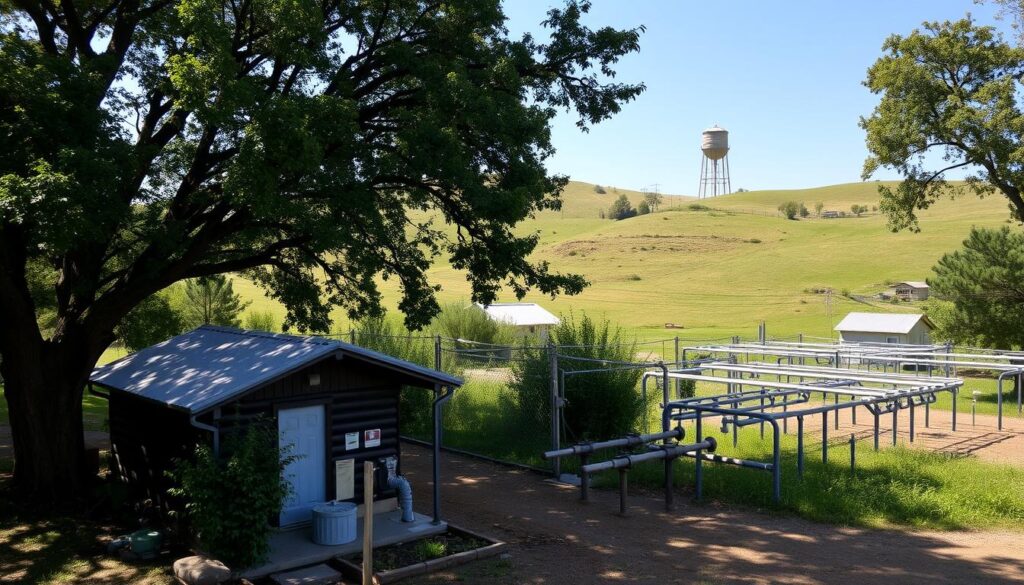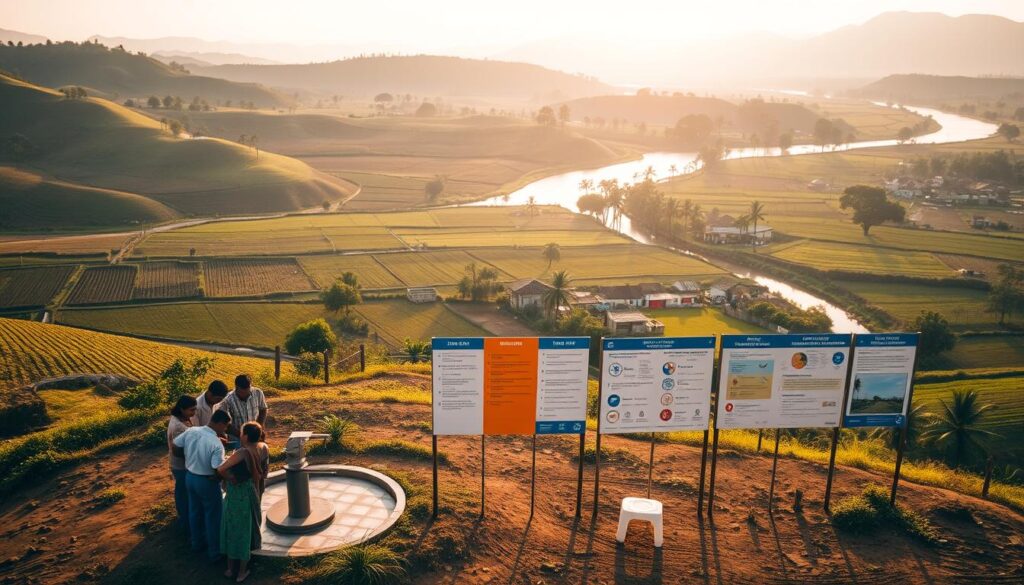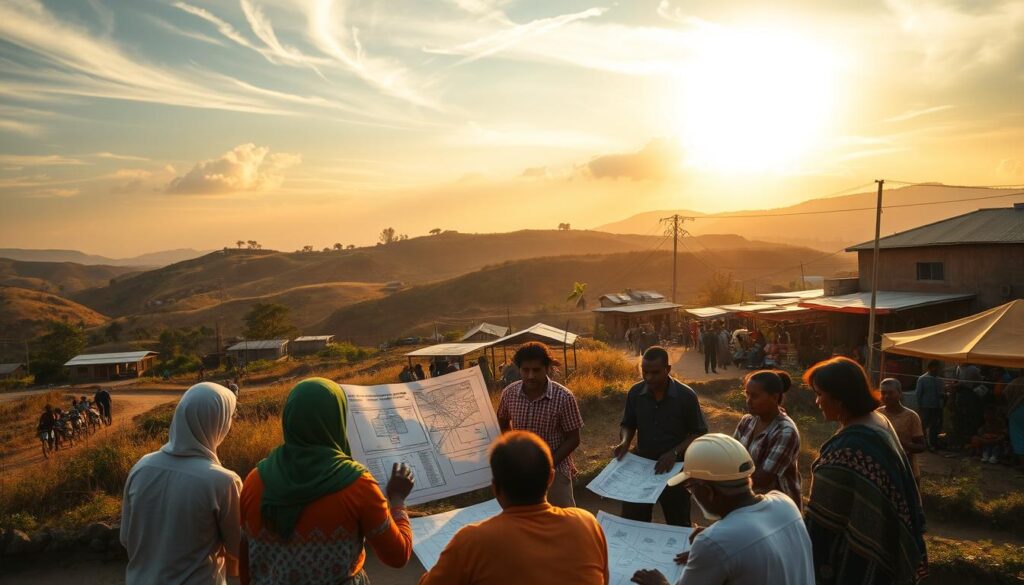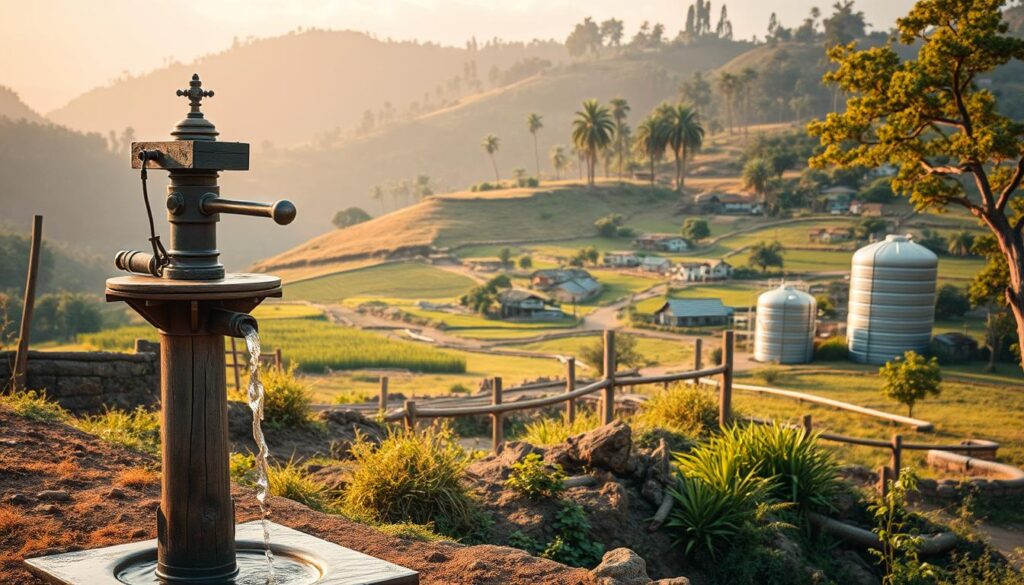Can a community of 110 houses survive with a water supply that comes only once every 15 days? For many rural areas, this is a harsh reality. The challenges are multifaceted, from finding a competent water source to dealing with legal conflicts over water rights.
Effective design of rural water projects requires a deep understanding of the local context and the application of sound engineering principles. Research funded by the Commission on Rural Water in 1973 highlighted the critical need for well-designed water systems in rural communities.
Key Takeaways
- Understanding the local context is crucial for designing effective rural water systems.
- Sound engineering principles are essential for reliable water supply.
- Rural communities face unique challenges in accessing clean water.
- Research and planning are key to successful rural water projects.
- Effective design can significantly improve the quality of life in rural areas.
Introduction to Rural Water Systems Engineering
Effective rural water supply systems are crucial for the health, economic development, and overall well-being of rural communities. “Access to safe water is a fundamental human right and essential for social and economic development,” as emphasized by global health organizations.
Rural water systems share general features with large urban water systems but must be tailored to the needs of rural populations. This involves understanding the unique challenges and characteristics of rural areas.
Definition of Rural Water Systems
Rural water systems are designed to provide clean water to communities outside of urban centers. These systems typically include water sources, treatment facilities, storage tanks, and distribution networks.
Key components of rural water systems include:
- Water source selection (surface or groundwater)
- Treatment technologies appropriate for rural settings
- Storage solutions such as elevated or ground tanks
- Distribution networks that may involve piping across long distances
Importance of Water Accessibility
Access to clean water is fundamental for public health, hygiene, and economic productivity. Communities with reliable water supplies are better positioned to develop economically and socially.
“Water is a critical component of human health and well-being, and its availability can significantly impact the quality of life in rural communities.”
Challenges in Rural Water Supply
Rural areas face unique challenges in providing water services, including dispersed populations, limited financial resources, and sometimes, complex terrain that complicates infrastructure development.
Some of the specific challenges include:
- Ensuring the sustainability of water sources
- Managing seasonal variability in water demand
- Maintaining infrastructure in remote areas
Understanding Water Demand in Rural Areas

Estimating water demand in rural areas involves a complex interplay of factors, including population size, usage patterns, and future growth projections. Accurately assessing these elements is crucial for designing rural community water systems that are both effective and sustainable.
Estimating Population and Usage
The first step in understanding water demand is estimating the population that the water system will serve. This involves analyzing demographic data, including current population, growth rates, and distribution. Usage patterns are also critical, as they vary significantly between residential, commercial, and industrial users. For instance, agricultural communities may have different water usage patterns compared to residential areas.
Seasonal Demand Variability
Seasonal variability is another key factor influencing water demand in rural areas. During certain times of the year, such as summer months, water demand may increase due to activities like irrigation and livestock watering. Understanding these fluctuations is essential for designing sustainable water solutions that can meet peak demands without compromising the system’s integrity.
Future Projections and Growth
Finally, projecting future growth and changes in water demand is vital for the long-term viability of rural water systems. This involves analyzing trends in population growth, economic development, and changes in water usage patterns. By considering these factors, planners can design systems that are adaptable and resilient, ensuring that rural community water systems remain effective over time.
Key Components of Rural Water Systems
Designing effective rural water systems involves several critical components. These systems are crucial for providing clean and reliable water to rural communities.
Water Source Selection
The first step in designing a rural water system is selecting a suitable water source. This could be a well, spring, or surface water body. The choice depends on factors like water quality, quantity, and sustainability.
- Assessing the yield and reliability of the source
- Evaluating water quality to determine treatment needs
- Considering the environmental impact of the source selection
Treatment Facilities
Once a water source is selected, the next step is to design appropriate treatment facilities. The goal is to remove contaminants and pathogens, making the water safe for consumption.
- Coagulation and flocculation to remove particulates
- Filtration to remove remaining impurities
- Disinfection to kill bacteria and viruses
Distribution Network Elements
The distribution network is a critical component that ensures water reaches consumers. It includes pipes, pumps, and valves. Proper sizing and material selection are vital to minimize losses and maintain water quality.
- Pipe material selection (e.g., PVC, HDPE)
- Pump sizing and energy efficiency considerations
- Valve placement for pressure management
Storage Solutions
Adequate storage is essential for maintaining a consistent water supply. Storage tanks can be elevated or ground-level, and their capacity should be designed to meet peak demand periods.
| Storage Type | Advantages | Disadvantages |
|---|---|---|
| Elevated Tanks | Good for pressure management | Higher construction cost |
| Ground-Level Tanks | Lower construction cost | Requires additional pumping |
By understanding and integrating these key components, rural water systems can be designed to be efficient, sustainable, and reliable.
Water Source Selection

The effectiveness of rural water projects heavily depends on the careful selection of water sources. This critical step involves evaluating various options to ensure a reliable and sustainable water supply.
Surface Water vs. Groundwater
Rural water systems can be supplied from either surface water or groundwater sources. Surface water sources, such as rivers, lakes, and reservoirs, are often more susceptible to contamination and seasonal variability. On the other hand, groundwater sources, accessed through wells and aquifers, generally offer better quality water but can be more expensive to develop.
When deciding between surface water and groundwater, it’s essential to consider factors like availability, quality, and the cost of extraction and treatment. A thorough assessment of both options is necessary to determine the most suitable source for a particular rural area.
Assessing Water Quality
Assessing the quality of the chosen water source is vital to ensure it meets the required standards for consumption and other uses. This involves conducting regular water quality tests to detect potential contaminants, such as bacteria, viruses, and chemical pollutants.
- Physical parameters like turbidity and temperature
- Chemical parameters including pH and contaminant levels
- Biological parameters to detect harmful microorganisms
Understanding these factors helps in designing appropriate treatment processes to make the water safe for use.
Sustainability Considerations
Sustainability is a key consideration in water source selection. It’s crucial to ensure that the chosen source can be maintained over the long term without depleting the resource or causing environmental harm. This involves evaluating the recharge rate of groundwater sources and the natural replenishment of surface water bodies.
Sustainable practices in water source management not only ensure the longevity of the water supply but also contribute to the overall health of the ecosystem. By choosing a water source wisely, rural communities can enjoy a reliable and continuous supply of clean water.
Treatment Technologies for Rural Water
Implementing the right water treatment technology is key to providing reliable and safe drinking water in rural settings. Rural water systems face unique challenges that require tailored solutions to ensure the water is clean and safe for consumption.
Conventional vs. Alternative Methods
Conventional water treatment methods, such as coagulation, sedimentation, and filtration, have been widely used in urban areas. However, these methods may not be feasible or cost-effective for rural communities due to their simplicity and the need for minimal maintenance. Alternative methods, including membrane filtration and UV disinfection, offer promising solutions for rural water treatment.
Alternative treatment technologies are often more suitable for rural areas because they are easier to operate and maintain. For instance, slow sand filtration is a simple, low-cost method that can be effective in removing pathogens and contaminants from water.
Filtration and Disinfection Techniques
Filtration and disinfection are critical steps in water treatment. Filtration removes particulate matter and microorganisms, while disinfection kills any remaining pathogens. Techniques such as chlorination, ozonation, and UV light disinfection are commonly used for disinfection.
In rural areas, the choice of filtration and disinfection technique depends on factors such as the quality of the raw water, the size of the community, and the available resources. For example, ceramic filtration is a cost-effective and efficient method for removing bacteria and viruses from water.
Cost-Effectiveness of Solutions
The cost-effectiveness of water treatment solutions is a crucial consideration for rural communities, where resources are often limited. The total cost of ownership, including initial investment, operation, and maintenance costs, should be evaluated when selecting a treatment technology.
Cost-effective solutions may involve using locally available materials, minimizing energy consumption, and optimizing system design. For instance, solar-powered water treatment systems can provide a sustainable and cost-effective solution for rural communities.
Designing Distribution Systems

Effective distribution system design is essential for ensuring consistent water supply in rural areas. A well-designed distribution system is critical for delivering water from the source to the end-users efficiently.
Pipe Material and Sizing
The selection of appropriate pipe materials and sizing is a crucial aspect of distribution system design. Pipe materials such as PVC, HDPE, and ductile iron are commonly used due to their durability and resistance to corrosion.
| Pipe Material | Advantages | Disadvantages |
|---|---|---|
| PVC | Cost-effective, resistant to corrosion | May become brittle with age |
| HDPE | Flexible, resistant to corrosion, and durable | Can be expensive |
| Ductile Iron | Strong, durable, and resistant to corrosion | Heavy, expensive |
Pressure Management
Pressure management is vital to prevent pipe bursts and ensure a consistent supply. Techniques such as pressure reducing valves and booster pumps are used to manage pressure within the distribution network.
Leak Detection and Monitoring
Leak detection and monitoring are critical for maintaining the integrity of the distribution system. Advanced technologies like acoustic sensors and SCADA systems are employed to detect leaks and monitor the system’s performance.
By focusing on these key aspects, rural water supply systems can be designed to be more efficient, sustainable, and reliable, ultimately enhancing water accessibility in rural communities.
Storage Solutions in Rural Settings
In rural areas, the design of storage solutions is critical for sustainable water systems. Storage solutions include elevated and ground storage tanks, with considerations for capacity and maintenance being paramount.
Elevated vs. Ground Storage Tanks
The choice between elevated and ground storage tanks depends on several factors, including topography, available space, and budget. Elevated tanks provide gravity-fed pressure, reducing the need for pumping equipment, which can be advantageous in rural areas where energy resources might be limited.
Ground storage tanks, on the other hand, are often less expensive to construct and maintain. They require pumping to distribute water, which can add operational costs. However, they can be more aesthetically pleasing and less obtrusive in certain landscapes.
Considerations for Capacity
Determining the appropriate capacity for storage tanks involves estimating the daily water demand, considering peak usage periods, and accounting for potential future growth. Capacity planning is crucial to ensure that the water supply remains reliable during periods of high demand or when maintenance is required.
- Assess current and future water needs
- Consider seasonal demand variability
- Plan for emergency reserves
Maintenance and Inspection
Regular maintenance and inspection are vital to extend the lifespan of storage tanks and ensure water quality. This includes routine checks for leaks, sediment buildup, and structural integrity. Maintenance protocols should be established and followed diligently to prevent contamination and system failures.
By carefully designing and maintaining storage solutions, rural community water systems can achieve long-term sustainability and reliability, supporting the overall water infrastructure development in these areas.
Regulatory Framework and Standards

Rural water projects must comply with a multifaceted regulatory framework that includes federal, state, and local guidelines. This framework is designed to ensure the safety, sustainability, and effectiveness of rural water systems.
Federal Guidelines
Federal guidelines play a crucial role in shaping the regulatory landscape for rural water projects. The Safe Drinking Water Act (SDWA) is a key piece of legislation that sets standards for drinking water quality. The Environmental Protection Agency (EPA) is responsible for enforcing these standards, which include limits on contaminants and requirements for water treatment.
The EPA also provides guidance on the implementation of water treatment technologies and the management of water distribution systems. Compliance with federal guidelines is essential for ensuring that rural water systems provide safe drinking water to consumers.
State and Local Regulations
In addition to federal guidelines, rural water projects are subject to state and local regulations. These regulations can vary significantly from one jurisdiction to another, reflecting local conditions and priorities. State regulations may include specific requirements for water source protection, treatment, and distribution.
Local regulations may also play a role, particularly in areas with unique environmental or public health concerns. For example, local ordinances may dictate the design and construction of water storage facilities or the implementation of water conservation measures.
Environmental Impact Assessments
Environmental impact assessments are a critical component of the regulatory framework for rural water projects. These assessments help identify potential environmental risks associated with water system development and operation. They consider factors such as water source sustainability, habitat disruption, and the impact of water treatment processes on the environment.
The results of environmental impact assessments inform the design and implementation of rural water projects, ensuring that they are environmentally sustainable and compliant with relevant regulations.
| Regulatory Level | Key Components | Responsibilities |
|---|---|---|
| Federal | Safe Drinking Water Act, EPA guidelines | EPA enforcement, water quality standards |
| State | Water source protection, treatment requirements | State agencies, public health departments |
| Local | Ordinances, water conservation measures | Local governments, water utilities |
By understanding and complying with the regulatory framework, rural water projects can ensure the delivery of safe, reliable drinking water while minimizing their environmental footprint.
Community Engagement in Water Projects
Community engagement plays a crucial role in the sustainability of rural community water systems. It involves not just the participation but also the active involvement of stakeholders in the decision-making process.
Importance of Stakeholder Involvement
Stakeholder involvement is critical because it ensures that the water project meets the actual needs of the community. Local residents are more likely to support and maintain a project they had a hand in designing.
Moreover, stakeholder involvement brings diverse perspectives to the table, enhancing the project’s overall quality and acceptance.
Methods for Community Consultation
Effective community consultation can be achieved through various methods, including public meetings, surveys, and focus groups. Public meetings provide a platform for direct interaction between project developers and the community.
Surveys help in gathering quantitative data on community preferences and concerns, while focus groups offer in-depth qualitative insights.
Building Trust and Transparency
Building trust with the community is paramount. This can be achieved by being transparent about the project’s goals, timelines, and challenges. Regular updates and open communication channels foster a sense of trust and cooperation.
| Method | Description | Benefits |
|---|---|---|
| Public Meetings | Direct interaction between project developers and the community. | Immediate feedback, builds trust. |
| Surveys | Gathering quantitative data on community preferences. | Helps in understanding community needs. |
| Focus Groups | In-depth discussions with community members. | Provides qualitative insights. |
By engaging the community effectively, rural water projects can ensure they are meeting the needs of the local population, thereby enhancing their sustainability and success.
Financing Rural Water Systems

Rural water systems require substantial investment, and understanding the financing options is crucial for their development. The complexity of financing rural water projects lies in the variety of funding sources and models available.
Traditional Funding Sources
Traditional funding sources for rural water systems include government grants and loans. These funds are often allocated through federal and state programs aimed at improving water infrastructure. For instance, the U.S. Department of Agriculture’s Rural Utilities provides financial assistance to rural communities for water and wastewater projects.
“Government grants and loans remain a cornerstone of financing for rural water projects,” as stated by water infrastructure experts. These traditional funding sources are vital for initiating and sustaining water development projects in rural areas.
Innovative Financing Models
In addition to traditional funding, innovative financing models are gaining traction. These include green bonds, water impact investments, and crowdfunding platforms. Green bonds, for example, are specifically earmarked for environmentally friendly projects, such as water conservation initiatives.
According to a report by the Environmental Finance Group, “green bonds have emerged as a significant financing tool for water infrastructure development.” This trend is expected to continue as investors increasingly look for sustainable investment opportunities.
Public-Private Partnerships
Public-private partnerships (PPPs) represent another critical financing mechanism for rural water systems. PPPs involve collaboration between government agencies and private sector companies to finance, develop, and operate water infrastructure.
The benefits of PPPs include not only financial support but also the introduction of private sector efficiencies and expertise. As noted by industry experts, “PPPs can bring significant value to rural water projects by leveraging private sector capabilities.”
In conclusion, financing rural water systems is a multifaceted endeavor that requires a combination of traditional funding sources, innovative financing models, and public-private partnerships. By understanding and leveraging these options, rural communities can secure the necessary resources to develop and maintain their water infrastructure.
Implementation and Construction Considerations
The construction of rural water systems demands a comprehensive approach to project management, encompassing various critical elements to ensure successful implementation.
Project Management Best Practices
Effective project management is the backbone of any successful rural water supply project. This involves adopting best practices such as setting clear objectives, establishing a realistic timeline, and allocating resources efficiently. By doing so, project managers can mitigate risks and ensure that the project stays on track.
Moreover, engaging with local stakeholders and incorporating their feedback into the project plan can significantly enhance the project’s relevance and acceptance within the community. This collaborative approach also helps in identifying potential issues early on, allowing for timely interventions.
Quality Control Measures
Implementing robust quality control measures is vital to ensure that the rural water system meets the required standards and is safe for use. This includes regular inspections during construction, testing of materials, and compliance with regulatory requirements.
Quality control also extends to the selection of contractors and suppliers. Ensuring that they have a proven track record and adhere to best practices can significantly impact the overall quality of the project.
Timeline Development
Developing a realistic project timeline is crucial for the successful implementation of rural water systems. This involves breaking down the project into manageable phases, setting milestones, and establishing deadlines. A well-planned timeline helps in coordinating the various activities and resources, ensuring that the project progresses smoothly.
It’s also important to build in flexibility to accommodate any unforeseen delays or challenges that may arise during the construction process. By doing so, project managers can minimize the impact of such issues and keep the project on track.
Operation and Maintenance of Water Systems

Effective operation and maintenance are crucial for the long-term sustainability of rural community water systems. Ensuring that these systems function properly involves a combination of routine maintenance, emergency response planning, and training local personnel.
Routine Maintenance Protocols
Routine maintenance is essential to prevent system failures and ensure the water quality meets safety standards. This includes regular inspections of water treatment technologies and distribution infrastructure. Maintenance protocols should be tailored to the specific needs of each rural community water system, taking into account factors such as age, capacity, and usage patterns.
Regular tasks may involve checking for leaks, cleaning or replacing filters, and inspecting valves and pumps. Keeping detailed records of maintenance activities helps in identifying recurring issues and planning future upgrades or repairs.
Emergency Response Planning
Despite best efforts in maintenance, emergencies can still occur. Having a robust emergency response plan in place is vital to minimize disruptions and ensure the continued supply of safe water. This plan should include procedures for responding to natural disasters, equipment failures, and contamination events.
Training local personnel in emergency response is a critical component of this planning. By empowering community members with the knowledge and skills needed to respond effectively, rural water systems can reduce their vulnerability to unforeseen events.
Training Local Personnel
Training local personnel is a key aspect of maintaining rural water systems. By educating community members on the operation and maintenance of these systems, communities can become more self-sufficient and resilient. Training programs should cover a range of topics, from basic maintenance tasks to more complex troubleshooting and repair.
Effective training not only enhances the sustainability of rural water systems but also fosters a sense of ownership and responsibility among community members. This, in turn, can lead to improved system performance and longevity.
Monitoring and Evaluation Strategies
To ensure the sustainability of rural water systems, it’s essential to implement robust monitoring and evaluation strategies. Effective monitoring involves tracking the performance of the water system, identifying potential issues before they become major problems, and making data-driven decisions to improve the system’s overall efficiency.
Key Performance Indicators
Key Performance Indicators (KPIs) are crucial for assessing the effectiveness of rural water systems. These indicators may include metrics such as water quality, system uptime, and user satisfaction. By establishing clear KPIs, stakeholders can evaluate the system’s performance and identify areas for improvement. For instance, a study on rural water systems highlighted the importance of monitoring water quality to prevent health risks water quality monitoring.
Data Collection Methods
Effective data collection is vital for monitoring and evaluation. Various methods can be employed, including surveys, remote sensing technologies, and on-site inspections. The choice of method depends on the specific KPIs being tracked and the resources available. Remote sensing technologies, for example, can provide real-time data on water levels and quality, enabling swift action in response to changes.
Continuous Improvement Practices
Continuous improvement is essential for the long-term sustainability of rural water systems. This involves regularly reviewing KPIs, assessing the effectiveness of current practices, and implementing changes as needed. By adopting a culture of continuous improvement, stakeholders can ensure that the water system remains efficient, effective, and responsive to community needs.
Implementing these strategies requires a collaborative effort from all stakeholders, including local communities, engineers, and policymakers. By working together, it’s possible to create sustainable water solutions that meet the needs of rural populations.
Case Studies of Successful Rural Water Systems

Examining case studies of rural water systems reveals valuable insights into their design and implementation. These examples not only highlight the challenges faced but also showcase innovative solutions that have been successfully adopted.
Examples from the United States
In the United States, various rural water projects have been undertaken to address the unique challenges of water accessibility. For instance, the Rural Utilities Service (RUS) has supported numerous projects, providing funding and technical assistance to rural communities.
One notable example is the rural water project in a small town in Nebraska, where a new water treatment facility was constructed to serve the local population. This project involved the use of advanced filtration technologies and was designed to be sustainable and cost-effective.
| Project Location | Key Features | Impact |
|---|---|---|
| Nebraska, USA | Advanced filtration, sustainable design | Improved water quality for 5,000 residents |
| Oklahoma, USA | Community engagement, water conservation measures | Reduced water consumption by 20% |
Lessons Learned from Global Perspectives
Globally, rural water projects have also seen significant successes, offering valuable lessons for other regions. For example, in Africa, community-based management of water systems has been a key factor in their sustainability.
“Community involvement is crucial for the long-term success of rural water projects. By engaging local residents in the planning and management process, projects can better meet the needs of the community and ensure their sustainability.”
A case study from a rural village in Africa highlighted the importance of rural engineering services in designing a water system that was both effective and sustainable. The project utilized local materials and labor, reducing costs and enhancing community ownership.
These case studies demonstrate that with careful planning, community engagement, and the right technology, rural water systems can be designed to meet the needs of their users effectively.
Future Trends in Rural Water Engineering
Future trends in rural water engineering will be characterized by a blend of technological innovation, climate resilience strategies, and policy developments. As the demand for clean and accessible water continues to grow, the need for advanced and sustainable rural water systems engineering solutions becomes increasingly important.
Incorporating Technology and Innovation
The integration of technology in rural water systems is revolutionizing the way water is sourced, treated, and distributed. Innovations such as IoT sensors, smart metering, and advanced water treatment technologies are enhancing efficiency and reducing waste. For instance, smart water grids can detect leaks and predict maintenance needs, minimizing losses and ensuring a more reliable supply.
Key technological advancements include:
- Advanced filtration and disinfection methods
- Renewable energy-powered water treatment systems
- Data analytics for predictive maintenance and demand forecasting
Climate Resilience Strategies
Climate change poses significant challenges to rural water systems, with changing precipitation patterns and increased frequency of extreme weather events affecting water availability and quality. Climate resilience strategies are crucial for ensuring the long-term sustainability of these systems.
Effective strategies include:
- Diversifying water sources to reduce dependence on a single source
- Implementing flood-resistant construction and floodplain management
- Enhancing water storage capacity to mitigate droughts
“Resilience is the ability to absorb or withstand shocks and stresses. In the context of rural water systems, it means being prepared for the impacts of climate change and other challenges.” – Water Infrastructure Expert
Policy Developments and Implications
Policy developments play a critical role in shaping the future of rural water engineering. Regulatory changes and funding allocations can significantly impact the implementation of new technologies and resilience strategies.
Key policy areas include:
- Water quality standards and regulations
- Funding for water infrastructure development
- Support for research and development in water technologies
As policy evolves, it is essential for stakeholders to stay informed and engaged in the development process to ensure that the needs of rural communities are met.
Conclusion: Towards Sustainable Rural Water Systems
Achieving sustainable rural water systems requires a concerted effort from all stakeholders. By understanding the complexities of rural water supply, we can design systems that are not only effective but also sustainable.
Key Takeaways
The design of rural water systems involves several critical components, including water source selection, treatment technologies, and distribution networks. Ensuring the sustainability of these systems is crucial for the long-term accessibility of clean water in rural areas.
Call to Action
Stakeholders, including policymakers, engineers, and local communities, must work together to implement sustainable water solutions. Investing in rural community water systems is essential for promoting health, economic development, and environmental sustainability.
Future of Water Accessibility
The future of water accessibility in rural areas depends on our ability to adapt to changing conditions and to innovate in our approach to water system design. By prioritizing sustainable water solutions, we can ensure that rural communities have access to clean, reliable water for generations to come.
